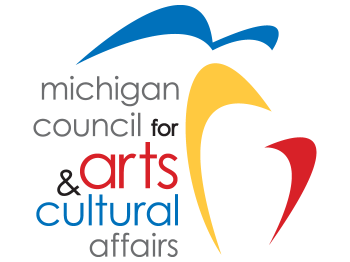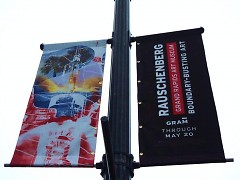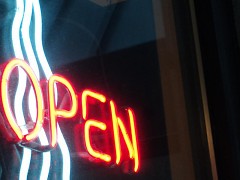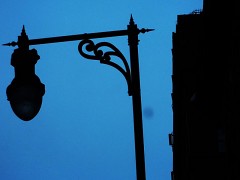Upon arriving at the Grand Rapids Art Museum (GRAM) for the Rauschenberg installment of their weekly series, Friday Night Conversations, I really had no idea what to expect. On the second floor I found Terry Johnston, the local photographer whose path I had crossed only a couple of times before, and who tonight, was to be our guide through the GRAM's extensive Rauschenberg exhibit. After welcoming us Terry briefly outlined the evening: first we were to head up to the third floor to see the portion of the exhibit called the Synapsis Shuffle, where he was tell us a bit about Robert Rauschenberg as an artist. Following that the group was to take to the streets with our cameras to employ the techniques we had just learned in the hopes of channeling Rauschenberg's photography methods and implementing them in our own creative endeavors. And lastly, we'd wrap up with a quick stop on the second floor of the exhibit before eventually returning to the Synapsis Shuffle for any last minute questions or observations.
Robert Rauschenberg was an American artist whose work focused on the unvarnished world he encountered throughout his daily life. He invented what is now known as "point and shoot photography," wherein he would proceed to wander the streets indiscriminately photographing everything he saw. This was at a time when photographers were known only for creating polished, posed works taken within a studio setting, and as a result of the high contrast between the traditional artistic standard and what Rauschenberg was producing, the artist's work was overwhelmingly met with criticism. It was as a result of the general response to his work that he gave up photography as his official medium, and took to the more nontraditional media of screen-printing and collage instead. His art eventually came to embody and originate what today is more widely known as pop art.
Following Johnston's brief lecture we were released into the cloudy downtown evening to snap photographs for a half an hour (employing time limits was a part of Rauschenberg's photography process). The hope was that we would accumulate enough pictures to print off and make our own Rauschenberg-inspired collages in the future. (Admittedly, with my limited access to a printer, I’m not sure how likely it is that I’ll be able to participate in this particular aspect any time in the near future, but I absolutely take and agree with both Rauschenberg and Johnston’s overall points). Terry insisted that the pictures themselves did not need to be perfect and that in fact we should let some of them blur and implement other nontraditional photography techniques. He also encouraged us to wait a few days before looking at our photos, and when we did, to resist the urge to delete any of them (it's been theorized that Rauschenberg not only never threw away any of his photos, but that all of them eventually got used in his collective body of work). Part of the purpose of this event was to encourage us to make art with confidence and without pre-judging its quality. "With art there's no wrong way to do it and it's up to you how to create it," were Johnston's words of encouragement on the proposed collage project.
Upon returning to the "Synapsis Shuffle" we learned that Grand Rapids is the third city in the world to display this collection of Rauschenberg's work (New York and Paris are the other two). The collection is on loan to the GRAM from the Whitney Museum of American Art and the exhibit will continue to run until May 20th. Johnston’s workshop only served to increase my excitement about the Rauschenberg show. I saw it once back in March and I recall liking it a lot, but I think seeing the exhibit and practicing the artist’s own methods immediately after helped me understand his art more than I initially did. The idea of art not having to be perfect or needing to live up to a particular set of standards is part of what makes Rauschenberg so accessible. He didn’t like the rigidity of photography standards so he broke free of them, and it’s only when artists are willing to push the envelope that art as a whole can continue to grow. And I think that was the point of our 30 minute photography spree: to be willing to experiment and branch out from our preconceived parameters about what art is and how it’s created and to try, in the future, to apply it to ourselves and our own creative endeavors.
The Rapidian, a program of the 501(c)3 nonprofit Community Media Center, relies on the community’s support to help cover the cost of training reporters and publishing content.
We need your help.
If each of our readers and content creators who values this community platform help support its creation and maintenance, The Rapidian can continue to educate and facilitate a conversation around issues for years to come.
Please support The Rapidian and make a contribution today.




Comments
Great article Laurel. That sounds like it was a fun excursion. I am disappointed I missed it. Really like the lamp post photo...nice black and blue simple yet striking image.